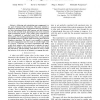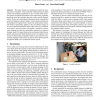2351 search results - page 109 / 471 » Tagging Human Knowledge |
93
Voted
CVPR
2004
IEEE
15 years 12 months ago
2004
IEEE
Recognition difficulty is statistically linked to ??? subject covariate factors such as age and gender for three face recognition algorithms: principle components analysis, an int...
SAINT
2008
IEEE
15 years 4 months ago
2008
IEEE
The utility of walking parameters such as stride length, cadence and gait velocity for monitoring motor functions of patients suffering from brain injury, Parkinson’s disease an...
ROMAN
2007
IEEE
15 years 4 months ago
2007
IEEE
— Achieving and maintaining user engagement is a key goal of human-robot interaction. This paper presents a method for determining user engagement state from physiological data (...
CICLING
2004
Springer
15 years 3 months ago
2004
Springer
: Syntactic disambiguation frequently requires knowledge of the semantic categories of nouns, especially in languages with free word order. For example, in Spanish the phrases pint...
108
click to vote
ECAI
2008
Springer
14 years 11 months ago
2008
Springer
Abstract. The paper presents an implemented model for priming speech recognition, using contextual information about salient entities. The underlying hypothesis is that, in human-r...


